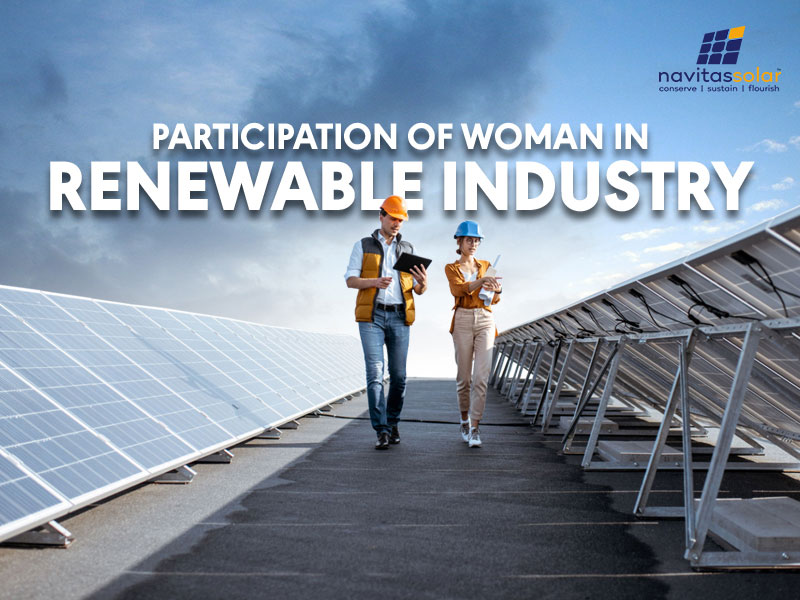Participation of women in Renewable Industry: A new paradigm for India’s growth: Indian Renewable Industry makes a shift!
Studies say that 3,30,000 jobs in the renewable sector (majorly solar & wind) will be created to accomplish India’s ambitious goal to install 175 GW renewables by 2022. According to the International Renewable Energy Agency (IRENA), Employment opportunities in India’s renewable energy sector will almost double by 2022. The report also noted that renewable energy employment continues to shift towards Asian countries. Currently, India’s Renewable Energy (RE) sector has low participation of women. According to the World Bank data, India is ranked 120th among 131 countries on female labour force participation. Majorly women employed in RE sector work at project sites, doing civil masonry work which is temporary and have very little participation for future growth.
When women participation in RE sector increases, it satisfies two ultimate Sustainable Development Goals (SDGs) like Gender Equity and Sustainable Economic Growth. Women’s proportion in rooftop solar sector stands at 11% whereas the global average of women in RE sector is 32%. However, this participation is higher compared to the other sectors like coal, oil, gas, electrical utility companies where the participation is 10%. Nevertheless, it is low compared to technology and services, financial sectors where women’s participation is 20-30%. International Monetary Fund (IMF) predicts that India will be richer by 27% by balancing the gender profile at workplace. Studies show that India can increase its GDP by up to 60% by 2025 by enabling more women to participate in its workforce. Yet, societal and cultural norms prevent it from becoming a reality. Increasing women’s participation in labour in RE sector will raise the quality and economy of women as well as of the organization too! Advancements should take place to increase participation of women for the transition to clean energy in India to balance the economy and to retain a diverse pool of talent. If no proactive steps are taken to address gender equity, Green Revolution may face some consequences as boosting the economy at the cost of marginalizing women and making them more vulnerable to poverty.
By improving opportunities of paid jobs in women leads to empowerment of women that results into better treatment with women, improved lifestyle, improved household dynamics and improved economy of a society. If public sector, private sector and government policies come together for women’s participation in clean energy sector, the quality life of women and their families will be improved. The basic problem with women’s participation in RE sector lies in formal education and training. There are very few women involved in production, operations, facilities, maintenance in RE sector. The problem and the opportunity are both clear.
India is a leading country in International Solar Alliance (ISA) having huge targets to install RE. National Institute of Solar Energy (NISE) and Skill Council for Green Jobs (SCGJ) are developed as training centers for RE sector. Now, this is the time to include gender equity in skill development initiatives and trainings. As the more women will be skilled in RE, the bigger advantage the sector will have! National skilling goals should now specifically decide a target to skill and train women in RE sector. Policy makers can accelerate the gender targeted policies to enable companies to advance towards gender parity and ensure that the sector’s growth. The “Step It Up” initiative is taken for gender equality in the world, it will set a standard for many other countries, and accelerate the momentum towards an equal world, a Planet 50-50, by the year 2030.
Factors governing the low representation of women include a lack of access to opportunities for women due to safety and security concerns at project sites, misperceptions of women’s capabilities in some roles; insufficient human resource policies beyond legally mandated requirements; societal norms and practices at workplaces and consciousness among employees.
The working conditions on many sites are not always suitable for women as they are devoid of safety and support systems and project and maintenance work require frequent visits at site. Training institutes could reduce the bar on entry, allowing less formally educated women to learn new skills and receive training. Training should be customized to respect specific needs like location, hours of engagement, safety and sanitation. Mobile training modules that can cater to small groups of women in remote areas can be developed.
Lack of social security measures to protect against illness, maternity, old age, job losses are the other factors responsible for low participation of women. The disparity existing between men and women regarding the pay scale is an unfortunate affair. The discussion on whether how fast, or even whether, that gap is closing always remains debatable.
Women in the solar sector continue to face the challenge of finding permanent employment along with a secure career. In addition to creating opportunities for women in technology installation, repair, dissemination, awareness generation, and marketing, there is a growing need within the energy sector to involve women in the formal engineering aspects of technology design and innovation.


 Online | Privacy policy
Online | Privacy policy
Related Posts
You May Also Like
Bonito Series: Driving Innovation in…
Read MoreTOPCon Series: The Next Generation…
Read MoreValuable Points to Remember During…
Read MoreNavitas Planet Partners with Hysolwin…
Read MoreDriving Towards a Sustainable Future:…
Read MoreWhy Do Top-Grade EVA Sheets…
Read MoreBonito Series: Driving Innovation in…
Read MoreTOPCon Series: The Next Generation…
Read MoreValuable Points to Remember During…
Read MoreNavitas Planet Partners with Hysolwin…
Read MoreDriving Towards a Sustainable Future:…
Read MoreWhy Do Top-Grade EVA Sheets…
Read MoreBonito Series: Driving Innovation in…
Read MoreTOPCon Series: The Next Generation…
Read MoreValuable Points to Remember During…
Read MoreNavitas Planet Partners with Hysolwin…
Read More